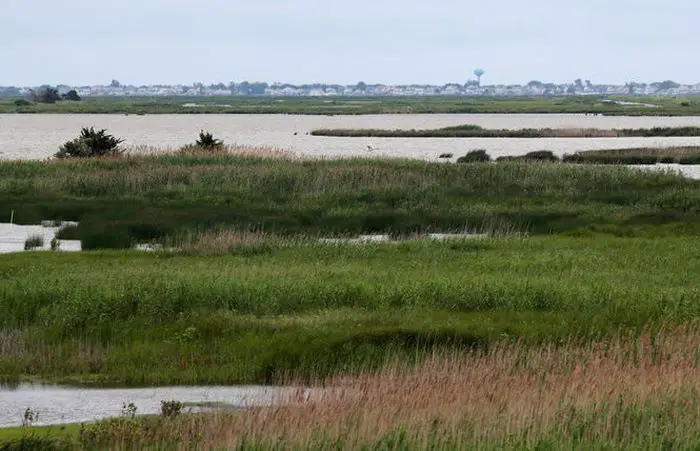For 5 years I lived on Mystic Island New Jersey, which is known as the Bug Capital of the world. The houses are built inside the salt marshes where after 5 pm in the summer you have to run from building to building or risk death by giant mosquitoes. But wait it gets worse. You know that Green Head Fly that bites you on the beach, they live there too a few miles off the Beach. Why Do Greenheads Flies Suck?
- All summer long Female Greenheads Flies attack causing pain afflicted wounds ruining vacations
- Bites cause swelling, itching & sometimes infection
- Greenheads attack animals along with beach dwelling humans for their Blood
- Because of their size, they are hard to control without harming the Environment
The worse bug bites come from NJ. It’s true. If the wind is just right and dies down, it gives the evil creatures a window of time, time to attack people laying on any NJ Beach half-naked and caught off guard. What makes this fly want to hang around on the Beach and ruin everyone’s vacation?
Greenhead Horse Fly
They are wicked, cruel, vicious giant flys with huge eyes and teeth that draw blood on the exposed skin of sunburned people who are left with welts that turn white, swell, puss, and bleed. It leaves out of staters with unanswered questions of “what the Hell was that” We locals, we know what it is. Greenheads. What we don’t know is, Why does it hurt so much when they bite? Where do they come from? How can we destroy them or send them all to Long Island NY? I found some answers. 
Greenheads attack horses, cattle, and barnyard animals, and along with humans, greenheads enjoy eating our blood. Any large animal is on the menu for Greenheads. They are very strong flyers and can make the trip from the marshes miles away to the beach with the help of a strong breeze. The biting itself doesn’t cause much pain to the victim you can watch it happen but an anticoagulant is also secreted into the injury, and that hurts. Man does it hurt.
 The Green bite doesn’t transmit any diseases but can cause swelling and pain that turns red and can become infected. In most cases, the bite will end up itching for a few days. The salt marsh Greenhead fly, Tabanus nigrovittatus, is an abundant summertime pest along New Jersey coastal marshes.
The Green bite doesn’t transmit any diseases but can cause swelling and pain that turns red and can become infected. In most cases, the bite will end up itching for a few days. The salt marsh Greenhead fly, Tabanus nigrovittatus, is an abundant summertime pest along New Jersey coastal marshes.
Because the females bite during daylight, and because they occur in large numbers, have a long flight range, and attack persistently, they interfere with the enjoyment of coastal areas throughout much of the summer.
 The population of the Greenhead peaks in July but unfortunately continue into September. If you are a boater and live in Jersey the best time is September and October after these monsters are gone. Jersey isn’t the only unfortunate place to be blessed by the greenhead. They’re found everywhere from Nova Scotia to Texas anywhere that has the coastal grasses that are prime spots for reproduction.
The population of the Greenhead peaks in July but unfortunately continue into September. If you are a boater and live in Jersey the best time is September and October after these monsters are gone. Jersey isn’t the only unfortunate place to be blessed by the greenhead. They’re found everywhere from Nova Scotia to Texas anywhere that has the coastal grasses that are prime spots for reproduction.
Beach Flies NJ
The female fly can lay 200 to 300 eggs after mating with the males who hang around the house all day and do the business with the females who then, in order to produce more eggs, look for blood that they need to make it happen. So they go where all the blood is. In the summer months, that would be the beaches of New Jersey. Where there is an abundant supply of vacationers with high-blood alcohol levels laying there half-naked on the sand waiting to serve it up.
They don’t seem to mind. Once they lay eggs back at the marsh the female Greenhead becomes very aggressive and will go after a blood meal. Blood serves as a rich protein meal and helps the female with this whole regeneration process. Of course, there isn’t much blood source back home in the marsh so they leave home in search of it.
The ways to control the flys have been impracticable because the amount of insecticide to kill them would cause other environmental problems. Both adults & larvae of greenhead flies are large in comparison to other, non-target organisms. Generally, more insecticide is needed to kill larger insects. The higher concentrations or greater amounts of toxic materials needed to obtain greenhead control have undesirable effects on other insects and animals in the same habitat.
According to John Stoffolano, University of Massachusetts Amherst “Unlike Mosquitoes who rely on smell to attack their prey, Greenhead Flies rely on sight. They have pretty good eyesight with massive green eyes and can use it. They are also attracted to darker colors and can detect body heat with their special thermal receptors in their antennae, explains Stoffolano. “First it’s vision: they see you, they fly to you, they land on you. With their thermal receptors, they identify you as a warm-blooded animal. That induces them to begin to probe or bite,” said Stoffolano. “Movement, color, and heat are all like a perfect recipe for getting hit by them,”
Why Do Greenhead Fly Bites Hurt
John Stoffolano explains “the bugs have special structures with teeth on them — like an arrow — that they push into your skin. Their mandibles, which are similar to a pair of razor-sharp scissors, cut the tissue. As all this is happening, the special teeth-like structures pull the head and mouthparts deeper into your skin. Then they use something similar to a sponge to channel the blood into their mouth” Not only do they punch a large hole in you, but they also gush in an antiseptic-saliva that stimulates blood flow. It burns and causes your nerves to respond with pain.
The pain and itch of a Greenhead Fly are painful, more painful than any other insect but won’t last as long. Dr. Edward Fog, Regional Medical Director for AtlanticCare Urgent Care located right in the middle of this battle zone said:
- wash the bite with soap and water.
- Avoid scratching the bite
- Instead, put hydrocortisone cream on it if it’s really itchy and keep it covered. A cool compress will also help.
- It should only last for a day or so
Greenhead Repellent
Some of the best ideas on how to keep these pesty devils away from you come from the locals who live with them all year long. Some of these include using garlic supplements, a mix of Listerine and water, a mix of vodka and citronella, DEET with dry gin, and Skin So Soft alone or mixed with mouthwash. Lisa Messinger, who has a place in Osborn Island in Little Egg Harbor Township, heard that cactus juice or dryer sheets will do the trick.
“They don’t really care too much about a lot of repellents,” said Lisa. A light-colored physical barrier is best, which includes long pants and long sleeves. Avoid wearing darker colors. Not quite beachwear for those beautiful days at the shore” Move closer to the water or stay in the water. Hope for the breeze to change.
I can tell you from experience that if the wind is East to West then you are in luck if you’re having a beach day as long as the wind is blowing. If the wind is West to East blowing offshore the beach day will include the Greenheads which you will have to deal with. The state of NJ has discovered a way of dealing with them with the use of traps in their own turf which is starting to pay off and show considerable reduction during the summer months.
If you live or vacation at the Jersey Shore then you are all too familiar with the Greenhead problem and do not deal with it on the beach on vacation but in your yard and any part of your life that you are exposed to them. Going shopping mowing the lawn or sitting on the porch. You have to deal with them. A trap like this Bite-Lite H-Trap Professional Horse Fly Control System Traps Horse Flies Without Chemicals or Electricity can be good if you want to enjoy your patio, especially during the summer night.
They are of professional quality. But nothing is going to stop the Greenhead from coming year after year. The Marshes that surround the Jersey area are beautiful and the Shore is a great vacation for the family. But you got to dance with the devil to enjoy it or the Greenhead I should say.
One resident of New Jersey says he found a repellant. Scott Macom, a lawyer from Galloway Township, New Jersey, says he has the solution. It’s the Greenhead Greenaid, Macom’s invention which he claims repels the big bloodthirsty bugs within three feet of where it’s placed in the sun. He has made bracelets for his daughters that they can wear when they go to the beach. The ingredient is a secret. “It chases away greenheads by the refraction of light that comes from the tube and the sun,” Macom said.
Greenhead Fly Trap
Greenhead traps were originally developed at Rutgers University to study fly populations but in their research studies found another use for them. A simple way to get rid of the pest that has taken the marshes and bay areas at the Jersey Shore hostage. Done without the use of pesticides that could eventually poison the natural habitats of turtles fish and birds among countless other species.
Traps should be set out when the first greenheads appear on the marsh (mid-to-late June) and kept in operation through August. Generally, maintenance is a simple matter. Traps should be inspected at least weekly during the peak of the fly season. At each inspection, dead flies should be emptied from the plastic containers and discarded, and tears or holes in the screens or sides should be patched or plugged. 
Trapped flies usually die in less than 24 hours and soon dry up and decompose. Traps perform best when the secondary collector is not clogged with flies, obscuring the light through the screen funnel. Thus frequent disposal of dead flies results in a more effective trap. Before storage, traps should be cleaned of flies and dirt. If stored indoors, they will last much longer.
The Greenhead Traps are box trap that gives an ecologically safe, inexpensive, and effective means of greenhead fly control available to anyone with the energy and manual dexterity to build one. Why not try to build and operate one or more of these trips this summer. Remember, for every fly you trap, there is one less female fly to bite. The same type of design can be used by residents down the Shore areas especially if you live near the Bays located where the marshes are home to breeding the Greenhead.
It’s hard to remember where I lived in the Back Bays of New Jersey without remembering the Bugs. You couldn’t sit in your own backyard and fish off your bulkhead for any period of time without being devoured by mosquitoes. Then the next day being tortured by the nastiest insect known to man The Greenhead Fly.
Make Your Own Greenhead Trap
The basic box trap design is diagrammed in Figure 1. Essentially the trap is a four-sided box having a screen top and open bottom. This box stands on legs so that its bottom is about 2 feet above the marsh surface. Flies enter the trap from below and move into secondary traps on the top of the box. The design is simple. The sides of the box can be made of a number of materials including plywood, cardboard, or plastic sheeting tacked to wooden framing. The trap dimensions have been developed experimentally and we urge the wise builder to pay strict attention to the following points:
- Build a box 15 x 32 inches on a side fastened to corner posts. We use 1/4 plywood and 1 x 2-inch furring strips, but other materials can be used. Also, nail a strip to the top of each side for later attachment of the screen top. The bottom of the box remains open. The optimal size for each side of the box is about 16 x 32 inches. In our tests, larger and smaller box traps were less efficient. Furthermore, these dimensions allow nine sides to be cut from a standard 4 x 8-foot panel. This means that the sides for nine traps can be cut from four 4 x 8 sheets of material.
- We use separate legs 40 inches long which are attached to the trap when it is placed for catching flies. The box is fastened so that its lower leg is 24 inches above the ground surfaces. This is important because the greenhead fly usually flies at about this altitude.
- The trap should be painted a glossy black to contrast with its surroundings and to absorb heat from the sun. Either shiny or dull black plastic sheeting attached securely to a frame is also satisfactory.
- The top of the trap should be made of a metal insect screen. Plastic screening or sheeting will be damaged readily by birds seeking to get at the trapped flies and should not be used.
- Take care in building the box and attaching the screen. Be sure there are no holes for the escape of trapped flies. Once inside the box, most flies move to the top of the trap, through the screen cones, and into collectors, as described in Step 8.
- Cut two holes in the screen roof of the box at diagonal corners. These holes should be 2 to 3 inches from the sides of the trap and 2 ½ inches in diameter. Make a cone of insect screen with a base of 2 ½ inches in diameter and 2 to 2 ½ inches high and with a hole ½ inch in diameter at the top. This can be done from the template shown in Figure 1a. After the piece of screen is cut, roll it into a cone and securely cement, staple or sew it with wire.
I copied the Template for the Cone from scale check but the dimensions should be dead on.
https://mywaterearth.com/how-long-does-floridas-red-tide-last/
JimGalloway Author/Editor
Reference: The Design comes from the Equine Science Center




